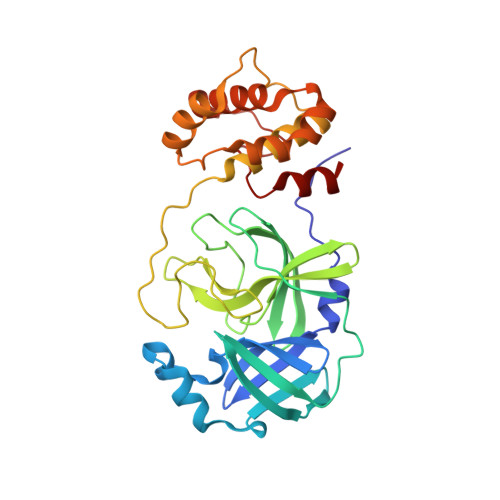SARS-CoV-2 M pro oligomerization as a potential target for therapy.
Lis, K., Plewka, J., Menezes, F., Bielecka, E., Chykunova, Y., Pustelny, K., Niebling, S., Garcia, A.S., Garcia-Alai, M., Popowicz, G.M., Czarna, A., Kantyka, T., Pyrc, K.(2024) Int J Biol Macromol 267: 131392-131392
- PubMed: 38582483
- DOI: https://doi.org/10.1016/j.ijbiomac.2024.131392
- Primary Citation of Related Structures:
9EPL, 9EPM, 9EUR, 9EUS, 9EWM, 9EWN, 9EWO - PubMed Abstract:
The main protease (M pro ) of SARS-CoV-2 is critical in the virus's replication cycle, facilitating the maturation of polyproteins into functional units. Due to its conservation across taxa, M pro is a promising target for broad-spectrum antiviral drugs. Targeting M pro with small molecule inhibitors, such as nirmatrelvir combined with ritonavir (Paxlovid™), which the FDA has approved for post-exposure treatment and prophylaxis, can effectively interrupt the replication process of the virus. A key aspect of M pro 's function is its ability to form a functional dimer. However, the mechanics of dimerization and its influence on proteolytic activity remain less understood. In this study, we utilized biochemical, structural, and molecular modelling approaches to explore M pro dimerization. We evaluated critical residues, specifically Arg4 and Arg298, that are essential for dimerization. Our results show that changes in the oligomerization state of M pro directly affect its enzymatic activity and dimerization propensity. We discovered a synergistic relationship influencing dimer formation, involving both intra- and intermolecular interactions. These findings highlight the potential for developing allosteric inhibitors targeting M pro , offering promising new directions for therapeutic strategies.
Organizational Affiliation:
Jagiellonian University, Malopolska Centre of Biotechnology, Virogenetics, Laboratory of Virology, Gronostajowa 7a, 30-387 Cracow, Poland; Faculty of Chemical Engineering and Technology, Cracow University of Technology, Warszawska 24,31-155 Cracow, Poland.


















